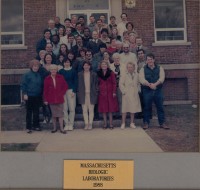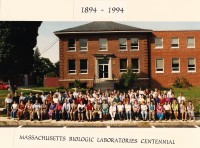Resources and Staffing Partnerships

Photograph-1988
To attract and retain professional staff qualified to carry out the mission of the Laboratories in production and development of biologics, a blended strategy for support was developed. First, there were in-kind or barter arrangements with other non-profit organizations such as described previously in relation to the Red Cross Blood Program. Secondly, collaboration was encouraged with scientists at research and medical institutions that funded the basic salaries. These medical researchers were attracted to the Laboratories by opportunities to work with “pedigreed” specimens that had been byproducts of the regular work done at the Laboratories. Thirdly, a small number of additional senior scientist positions were requested and obtained through the state’s Executive Office of Human Services, which subsumed the Department of Public Health. When possible, state positions could be divided into two half-time salaries, and the complementary part would be sought from research grant support.71
Another option presented itself with the Massachusetts Health Resource Institute ( MHRI), which had been founded in 1959 by Massachusetts Public Health Commissioner, Alfred Frechette, MD, and Governor Foster Furcolo. The original incorporators included deans from Harvard Medical School, Dr. George P. Berry, Harvard School of Public Health, Dr. John C. Snyder, and Tufts Medical School, Dr. Joseph M. Heyman, Jr., Director of the Boston University Massachusetts Memorial Hospital Medical Center,Dr. Chester S. Keefer, Massachusetts Commissioner of Administration and Finance, Charles F. Mahoney, Director of the Cancer Research Institute of New England Deaconess Hospital, Dr. Shields Warren, Vice President of the Federal Reserve Bank of Boston, Earle O. Latham, President of the Massachusetts Medical Society, Dr. Charles C. Lund, AFL-CIO Community Service Representative, Joseph D. McLaughlin, and the Honorable J.J. Spiegal of the Supreme Judicial Court of Massachusetts.(55)
MHRI was a non-profit organization founded to cooperate with the Department of Public Health (DPH), assisting in the management of a variety of projects and programs; some of the largest of these were completed at the Biologic Laboratories and other divisions of the State Laboratory Institute. In the original model, MHRI would partner with DPH when staff sought funding for short-term research projects; staff at the DPH facility would be the Principal Investigators and would write the content of grant applications, and MHRI would become the official grant applicant. If and when funding was awarded, MHRI would recruit and hire employees, procure the necessary equipment, and provide administrative support for the specific duration of each project or program. Thus, the staff working on each specific project or program would be legally employed by MHRI, but supervised by the DPH staff who had originally written the grant content72.
The Next Wave of Immune Globulins: Orphan Drugs in the 1980s and 1990s
Massachusetts Health Resource Institute ( MHRI) created a subsidiary company called Orphan Biologics Institute (OBI), the first non-profit of its type to be approved by the Internal Revenue Service under Chapter 501(c)3. Orphan Biologics were defined as special products that could be important to selected populations, usually of less than 200,000 nationally. During the 1980’s, the Biologic Laboratories developed an immune globulin product to combat cytomegalovirus (CMV). Cytomegalovirus, an orphan disease and member of the herpesvirus family, can have serious implications for babies infected before birth.73 CMV can also cause serious problems for people who have weakened immune systems, such as those infected with HIV and transplant recipients.
In 1990, Cytomegalovirus immune globulin, intravenous (human) (CMV-IGIV) was licensed by the U.S. Food and Drug Administration (FDA), and was the first biologic to be granted official Orphan Drug Status by the FDA. This official status gave the Biologic Laboratories a “7-year exclusivity of its use in kidney transplant populations (1990-1997), as well as for other solid organ transplant populations (1998-2004)”74. After the Biologic Laboratories obtained this federal license for CMVIG-IV, the Orphan Biologics Institute managed the conveyance of rights for the CMV-IGIV license to the MedImmune corporation under the MedImmune trade name Cytogam. A similar process was followed when MedImmune scientists collaborated on the development of respiratory syncytial virus ( RSV) immune globulin (“Respigam”).75 MedImmune, originally called Molecular Vaccines, Inc., was founded by Wayne T. Hockmeyer in 1988 and is based out of Gaithersburg, Maryland. The company changed its name to MedImmune in 1990.76 Although the rights for CytoGam were licensed to MedImmune, MedImmune was not licensed to manufacture products at the time, so CytoGam was manufactured at the Biologic Laboratories.77
At the same time CytoGam was being manufactured, the Biologic Laboratories began working with the California Department of Health Services to manufacture Botulism Immune Globulin Intravenous (Human) (BabyBIG). BabyBIG went into the clinical trial phase in 1992, and was licensed by the FDA in 2003. Like CMV, Infant Botulism is an orphan disease.78 Simultaneously, the Biologic Laboratories produced Pertussis Immune Globulin (PIG). PIG was developed to treat infants with Pertussis (Whooping Cough). Treatments for Herpes Simplex type II, Herpesvirus 6, and E. coli were also researched during the 1990s.79 In 1994, just a few years after the collaboration with the California Department of Health Services, the Biologic Laboratories signed an agreement with Harvard University to collaboratively conduct research on Recombinant Toxoids of Bacterial Exotoxins.80
The Centennial: Advancements on the Original Mission

Staff-1994
The year 1994 marked the Biologic Laboratories centennial, which was celebrated with an all-staff picnic. In 1894, an Antitoxin and Vaccine Laboratory run by Joseph Goodale in the State House was created to produce Diphtheria Antitoxin.81 By 1994, the Biologic Laboratories had expanded upon its original mission: not only did the Laboratories distribute childhood vaccines free of charge throughout Massachusetts via a decentralized network involving 350 local Boards of Health, but it had also developed and produced biologics to treat people suffering from orphan diseases throughout the country.
The centennial brought with it new collaborations and contracts, scientific breakthroughs, and change. In the early 1990s, the Biologic Laboratories was invited to become part of the “The Consortium,” a project of the Children’s Vaccine Initiative (CVI); the CVI was an American initiative created in 1990. The other two organizations involved in the project were Johns Hopkins University and the non-profit organization Program for Appropriate Technology in Health (PATH).82 By bringing together these three organizations, the CVI hoped to “bring to bear the formidable expertise of the three complementary organizations to solve” some of the issues that the CVI was handling in regards to vaccine research and development in Third World countries. Unfortunately, the project never went past the development stage.83 Instead, a new educational outreach opportunity for the Biologic Laboratories arose in 1995 in the form of the International Training Program, which was developed and managed by Dr. Siber. The program was funded by a grant from USAID for five years. The 3-week program, which helped scientists from developing countries learn quality control and Good Manufacturing Practices (GMPs), was held at the Biologic Laboratories, and taught by its employees. The original syllabus was written by Biologic Laboratories scientist Roger Anderson in 1994.84
In 1996, shortly after the USAID grant was awarded, the Biologic Laboratories was awarded a contract with the National Institutes of Health (NIH), who “sought a biologic manufacturer that could collaborate on products in NIH’s extra-mural research program.”85 This five-year contract, the Vaccine Production Facility for New Vaccines, was to support the development of vaccines and antibodies for new and emerging diseases. The contract was later extended through November 2005. During the later years of the contract, the Laboratories produced a variety of biologics, including a monoclonal antibody for treatment of cryptococcal disease in AIDS patients.86
The Development of RespiGam

informational
pamphlet,
printed
February-1996
In 1996, FDA granted approval of RespiGam (RSV-IG), an RSV-specific hyperimmune globulin developed for the prevention of Respiratory Syncytial Virus (RSV) developed at the Biologic Laboratories. Like CytoGam, RespiGam was also given Orphan Drug status. Development of RespiGam began in the 1980s, and was another collaboration between the Laboratories and MedImmune. Other funding sources included the NIH, who sponsored the first major clinical trial. The clinical trials began in 1989.87 “The screening technology to identify plasma rich in RSV antibodies was developed by” Dr. Siber and Dr. Leszczynski and scientist James McIver developed “the method for preparing a human antibody formation (immune globulin) that was safe for intravenous administration.”88 The process of manufacturing RSV-IG was patented in 1995, and the Laboratories then licensed the rights for RespiGam to MedImmune. In 1998, FDA also granted approval of SynaGis, a MedImmune product proven to be even more effective in preventing RSV. Because of the original licensing agreement between the Biologic Laboratories and MedImmune, the Laboratories had the right to manufacture SynaGis for use and sale in both Massachusetts and Maine.89
The R&D for RespiGam was managed by MHRI, rather than the Department of Public Health, just as with CytoGam: scientists from the Biologic Laboratories came to MHRI for funding, and MHRI was the official grant applicant. When it came time to manufacture, MedImmune, still a new company at the time, was not licensed as an FDA-approved manufacturer, so all the manufacturing of RespiGam was completed at the Biologic Laboratories, and was available for full distribution in February of 1996. For manufacturing purposes, MHRI created a subsidiary company called Orphan Biologics Institute (OBI), the first nonprofit to be approved by the Internal Revenue Service (IRS) under chapter 501 (c)3. OBI’s legal stated purpose was to manufacture orphan biologic products, such as RespiGam.90
As with any patent, the owner(s) has the authority to sell or license the rights to the patented product/process in exchange for royalties or fees. Typically, those royalties or fees are then divided amongst the different parties involved with the patent. In the case of RespiGam, MedImmune paid MHRI royalties of 3% of the profits for drug sales. Under MHRI’s standard royalties policy, which is typical for research institutions, of that 3%, 30% went to the named Biologic Laboratories inventor(s), 40% went back into the Biologic Laboratories, 10% went directly to the state of Massachusetts, and the remaining 20% to MHRI.91